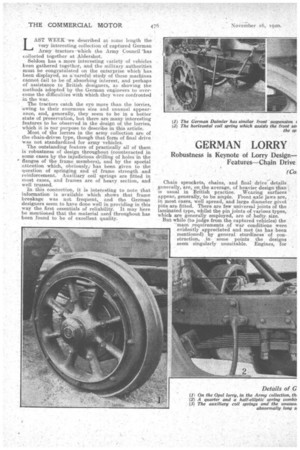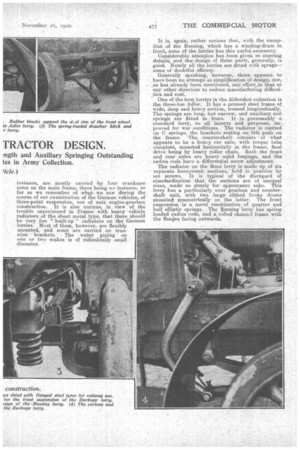GRMAN LORRY TRACTOR DESIGN.
Page 10

Page 11

Page 12

If you've noticed an error in this article please click here to report it so we can fix it.
LAST WEEK we described at some length the vary interesting collection of captured German Army tractors which the Army Council has collected together at Aldershot.
Seldom has a more interesting variety of vehicles been gathered together, and the military authorities must be congratulated on the enterprise which has been displayed', as a-careful study of these machines cannot -fail to be of. absorbing interest, and perhaps of assistance to British designers, as showing the methods adopted by the German engineers to overcome the difficulties with which they were confronted
_ in the war. ..
• The tractors catch the eye mere than the lorries, 'owing to their enormous size and unusual appearance, and, generally, they seem to be in a better state of preservation, but there are many interesting features to be observed in the design of the lorries, which it is our purpose to describe in this article. Most of the lorries in the army collection are of the chain-driven type, though that form of final drive ' was not standardized for army vehicles. The outstanding feature of practically all of them is robustness of design throughout (counteracted in some cases by the injudicious drilling of holes in the • flanges of the frame members), and by the special attention which, obviously,' has been given to the question of springing and of frame strength and reinforcement. Auxiliary coil springs are fitted in most cases and frames are of heavy section, and well trussed.
In this connection, it isinteresting to note that information is available which shows that frame breakage was not frequent, and the German designers seem to have done well in providing in this way the first essentials of reliability. It may here be mentioned that the material used throughout has been found to be of excellent quality. .
Chain sprockets, chains, and final drive--details generally, are, on the average, of heavier design than _ is usual in British practice. Wearing surfaces appear, generally, to be ample. Front axle jaws are, in most cases, well spread, and large diameter pivot pins are fitted. There are few universal joints of the laminated type, whilst the pin joints of various types, which, are generally employed, are of hefty. size.
But while (to judge from the captured vehicles) the
-main ,requirements of war conditions were evidently appreciated and met (as has been mentioned) by general sturdiness of construction, insome points the designs seem singularly unsuitable. Engines, for
instance, are mostly carried by four crankcase arms on the main frame, there being no instance, so far as we remember of what we saw during the course of our examination of the German vehicles, of three-point suspension, nor of unit engine-gearbox construction. It is also curious, in view of the trouble experienced in France with heavy vehicle radiators of the sheet metal type, that there should be very few " built-up" radiators on the German lorries. Most of them, however, are flexibly mounted, and some are carried on trunnion brackets. The water piping on one or two makes is of ridiculously small diameter.
It is, again, -rather curious that, with the excep... tinu of the Bussing, which has a winding-drumin front, none of the lorries has this useful accessory. . Considerable attention has been given to steering details, and the design of these parts, generally, is good. Nearly all the lorries are fitted withTspraigssome of doubtful efficacy.
Generally speaking, however, there appears to • have been no attempt at simplification of design nor, ,as has already been mentioned, any effort-in that or any other direction to reduce manufacturing difficulties and cost.
One of the best lorries in the Aldershot collection is the three-ton Adler. It has a pressed steel frame of wide, deep and heavy section, trussed longitudinally. The springs are long, but narrow, and auxiliary coil springs are fitted in front. It is presumably. a .standard lorry, to all intents and purposes,
proved for war conditions. The radiator is carried on C springs, the brackets resting on felt pads on the frame. The colintershaft consists of what appears to be a heavy car axle, with torque tube complete, mounted horizontally in the frame, final drive being by heavy railer chain.. Boththe front and rear axles are heavy solid forgings, and the radius rods have a differential screw adjustment.
The radiator on the Benz lorry is made up of six separate honeycomb sections,. 'held in position by set screws. It is typical of the disregard of standardization that the sections are of unequal." sizes, made so purely for appearance sake. This lorry has a particularly neat gearbox and countershaft unit, with two large ribbed brake drums Mounted symmetrically on the latter. The front suspension. is a novel combination, of quarter and half elliptic springs. The Bussing lorry has spring• loaded radius rods, and a rolled channel frame with the flanges facing outwards. The Durkopp is one of the few lorries provided with a sub-frame on which the units are mounted. The engine crankshaftis of the built-up type, both big-ends and main bearings being made of hardened steel and being non-adjustalole. The bearing surfaces are particularly small. This vehicle has an abnormally long steering drop arm of Heath 'Robinson conception' and a transmission brake of comparatively small diameter, but abnormal width, is fitted. There seems to be -a lack of proportion about-' it generally.
On the Gernian Daimler is to be seen one of those peculiar wheel improvisations which arose out of the tyre shortage due to the blockade. A series of square rubber blocks, located by pressed steel cups, is -interposed around the periphery of the wheel inside the plain steel band tyre.
One of the heaviest vehieles is the Dux, a curious point in the engine design being the projectionof the cylinders some distance into the crankcase. The rear springs are very long and wide, and the front axle design is good. This vehicle has four universal joints of the laminated steel ring type. An excellent method of frame trussing is adopted on the Hansa Lloyd. A long flat tie rod is fitted, . and is adjustable by means of a screwed vertical strut. The tie rods are anchored to the front and rear spring bracket-s. On the Mulag a somewhat similar systemis I.Aed, but two vertical coil springs on each side, carried in housings, tension the -rods. This vehicle has a large ribbed brake drum on its countershaft, and an excellent design of steering joint. On one vehicle there is an interesting set of rear wheel tyres. Apparently of rubber, they are stone hard, and only show a trace of resiliency, we are told, after being on the road for some time. • The Opel is one of the few vehicles with a built-up type radiator.. The toad wheels have been fitted with railway typo tyres,offset a. little to alter the track. Two gearboxes are fitted, presumably to admit of high speed reversing in railway use. An -interesting point on the Stoewer lorry is the external clutch spigot, which registers in a pressed steellrousing .bolted to the flywheel face. >-.' Altogether,the vehicles -are a -very interesting lot. Generally, any collection of " war relics" is apt to he regarded as a sort of museum, which merely serves as a reminder of conditions that will not recur, but we think, in this case, that is hardly so, and that there should be quite useful lessons to be 'learned from theseivehieles . which the Army authorities have. •so opportunely collected together. If we take one feature of design alone—namely, the auxiliary coilkspring–,is it not worth consideration for the purposes of commercial vehicle design1 .0bviously, it saved the German road springs from break
age on atrocious roads. Possibly, itsaved the mechanism also slightly.. The fitting of a coil -spring interposes a weak, easily replaceable, and perhaps • desirable link in the suspension chain. It is worth thinking about, and for such reasons alone, the collection well merits inspection.
In conclusion, we must express our thanks to the Army Council for, allowing us to examine and to photographthe vehicles. Our thanks are also due to the. Commandant, R.A.S.C. Training College, Aldershot, who facilitated our inspection, and partichlarly toLt.L-Coh: lintehinson, D.S.O.,who was our -guide, philosopher, and friend on this occasion, and from his inexhaustible store of knowledge of the " Automobile Beebe" made all things clear that otherwise might have been obscure.






























